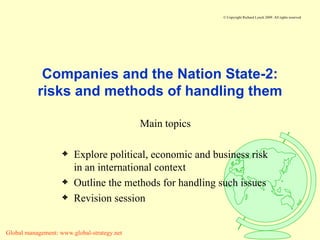Global Management 9
- 1. Companies and the Nation State-2: risks and methods of handling them Main topics Explore political, economic and business risk in an international context Outline the methods for handling such issues Revision session
- 2. Political, economic and business risk-1 Political risk: the probability that political forces will negatively affect a companyâs profit or impede the attainment of other critical business objectives Lynch Ch 19 Examples: India: desire to protect Indian companies and markets from foreign competition France: sensitive to acquisition of leading French companies by foreign MNEs USA: Government pressure on to Airbus over alleged subsidies for development of new aircraft Distinguish between: Macro political risk : affecting all MNEs in a country Micro political risk : affecting sectors of the economy only
- 3. Political, economic and business risk-2 Economics Falling GDP Inflation high Capital flight from country Foreign debts high Commodity dependence Low food output Society Urbanisation Drugs Corruption Ethnic tension Religious fundamentalism Politics Bad neighbours Strongly authoritarian Staleness: little change in rulers Lack of democracy Generals in power War including guerrilla conflict The following are all signs of macro political risk in a country: Source: Economist , 20th December 1986
- 4. Political, economic and business risk-3 Key issue: the forecasting and management of macro and micro political risks - see Lynch Ch 19 Evaluate the macro political risk: use E-S-P paradigm to explore Influences on the economy and consequent political risks Government actions Consider government lobbying and other means of making contact in order to explore the situation informally Evaluate the micro political risk in relation to specific industries: Local ownership Transferral of funds and profits Re-export of finished product Technology transfer Trade barriers, etc.
- 5. Political, economic and business risk-4 Company strategies for protection involving both macro and micro elements: Integrative techniques : become part of host country, e.g. IBM in Europe Protective techniques : maintain non-integration with host country, e.g. keep R&D in home country Strategic use of joint ventures and partnerships , e.g. with local companies Keypoint: carefully analyse strategic situation before entering into agreements.
- 6. Methods for handling risk-1 Well constructed negotiation strategies are essential for companies dealing with national governments Evaluation of position via: exploration of strengths and needs analysis of weaknesses identification of pressure points: particular areas where persuasion may be possible Important to understand behavioural characteristics of participants: culture ethics business style Difficulties: Authority level of negotiator Differing time horizons for objectives Social customs, language Use of written documents See Lynch Ch 19
- 7. Methods for handling risk-2 Buyer Maximum bid 25 Desired bid: 23 Minimum: ? Seller Maximum ? Desired bid 24 Minimum 21 Negotiation strategies include: Building interpersonal relationships prior to the deal: some cultures only Discovery of time pressures on other party Reciprocity: trading favours Some negotiators start with, or demand, extreme offers to change expectations Promises, threats, rewards, commitments, etc. Example of acceptance zone :
- 8. Methods for handling risk-3 Many negotiations conducted by companies are complex and take months to complete: some possible guidelines: Important not to get trapped into being committed to the initial proposal Several parties may be involved in negotiations: Company should not assume that local negotiator has full authority: check Locals should not assume that team from company have unlimited experience Government may wish to examine the extent to which this deal will become a test case for whatever policy it is pursuing Companies should try to lower the expectations of their potential partners: e.g. better to clarify tricky areas early in the deal Governments need to be shown that it is not possible to impose performance guarantees: better to seek information on resources, motivations and expectations of each party Usually better to withdraw rather than accept a flawed deal.







